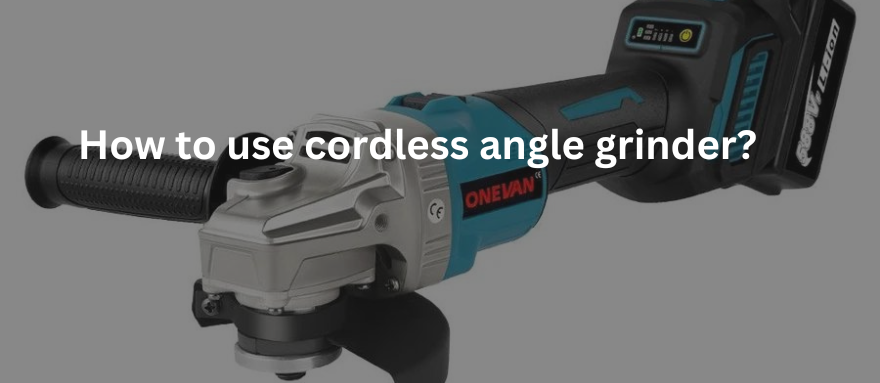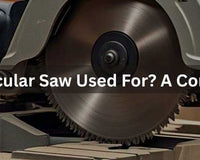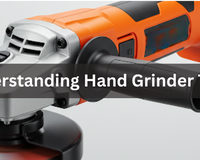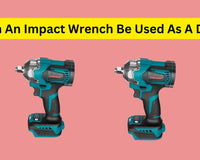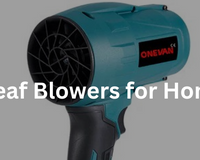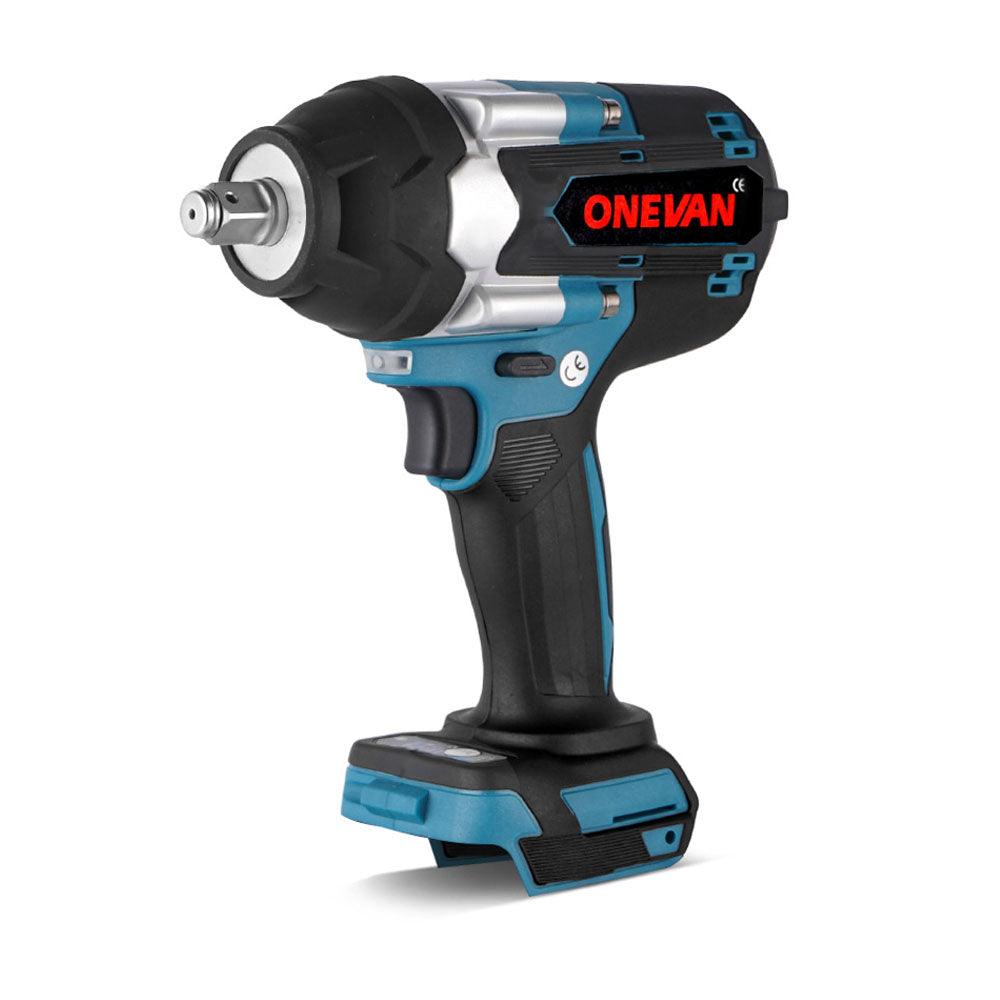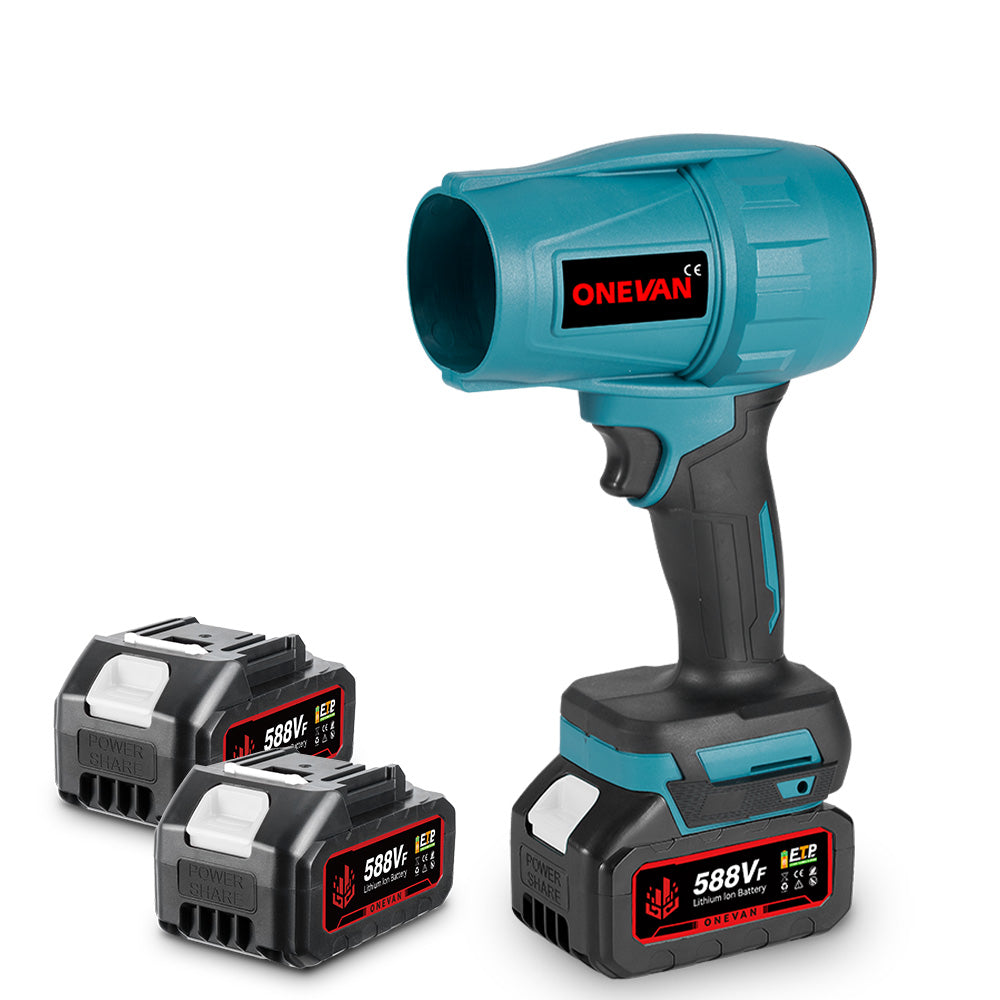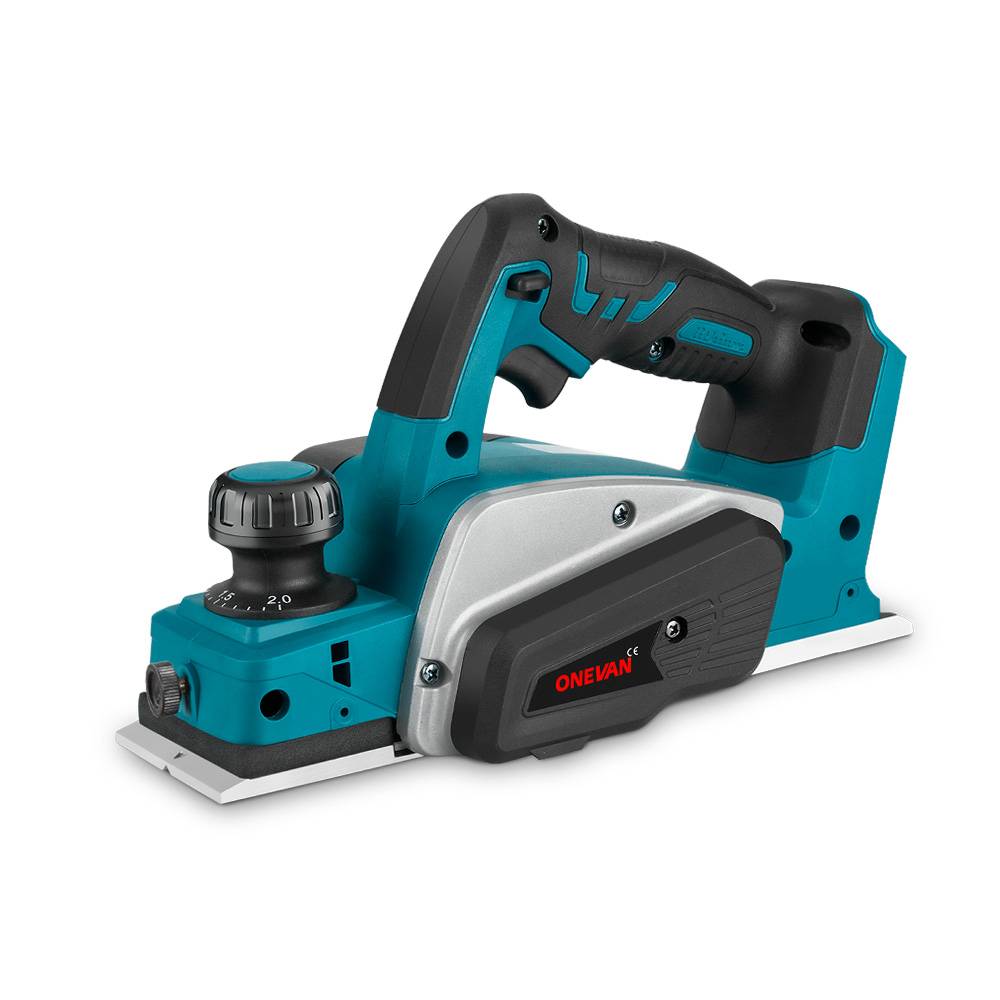You may think a cordless angle grinder is mainly used for cutting metal, but experienced do-it-yourselfers will find this power tool handy for all kinds of projects. You can buy a variety of different abrasive wheels and cutting wheels that make this a helpful tool when you know how to handle it. When changing the wheels, ensure the tool is powered off and the battery is removed.
So, what are you going to learn in this article?
- Understanding a cordless angle grinder
- The difference between an angle grinder and a polisher
- How to use an angle grinder?
- Different types of Wheels used in angle grinders
- Maintenance Tips
1. What is a Cordless Angle Grinder?
One of the key advantages of a cordless angle grinder is its portability. Without the encumbrance of a power cord, you can take the tool wherever it's needed, whether you're working at a remote job site or in a home workshop. Furthermore, the angled head design improves your visibility and control over the tool, allowing you to work with greater precision.
Cordless angle grinders are typically equipped with a side handle, which you can use for a two-handed grip. This additional grip enhances stability and control, making it easier and safer to guide the tool through cuts or over a surface. When maneuvering the grinder, always ensure you maintain a firm grip and utilize the safety guard to protect yourself from sparks and debris. The safety features along with precise control provide both efficiency and security in your grinding tasks.
At the heart of many modern cordless angle grinders is a brushless motor, which is more efficient and longer-lasting than traditional brushed motors. This efficiency means more power and a longer runtime on a single battery charge. Among ONEVAN, this 12V 500W Cordless Mini Brushless Angle Grinder is particularly popular and can meet most people’s needs for Pipe cutting, equipment maintenance. Hydropower installation, PVC pipe cutting, daily maintenance etc.
2. How Does a Cordless Angle Grinder work
When you press the power button, the lithium-ion battery supplies electrical energy to the tool's motor. The motor then converts this electric energy into mechanical energy, causing the grinding wheel or cutting disc to rotate at speeds typically exceeding several thousand RPM. As the grinding wheel spins, you can bring it into contact with the material you're working on. For example, if you're cutting through a metal pipe, the high-speed rotation of the wheel will slice through the pipe due to the abrasive surface of the wheel. Or, if you're using a flap disc, the rotating motion is ideal for polishing and smoothing surfaces such as metal or stone.
3. What Is The Difference Between Cordless Angle Grinder And Coddled Models?
One significant difference between the two models is how they get their energy. Although it is self-evident from the names, you can differentiate order from an angle grinder with a wire, which gets its energy from a power outlet.
On the other hand, a cordless angle grinder works on a battery. This rechargeable battery provides energy to the grinder, distinguishing it from corded models. A cordless angle grinder has several significant advantages over corded models, including portability, ease of use in tight spaces, and freedom from tangling cords. Battery-operated angle grinders are easy to carry and operate in confined spaces, such as tight corners or small workshops.
4. How to Choose a Cordless Angle Grinder
Which is the best cordless angle grinder for you? Your choice depends on several factors, such as:
- Battery voltage and capacity: Higher voltage generally requires more power. However, battery capacity determines runtime.
- Wheel size: The size of the abrasive wheel impacts the tool's cutting or grinding capacity.
- Motor speed: Higher speeds are suitable for tough applications. Subsequently, lower speeds allow better control during work.
- Weight and ergonomics: The tool's weight and balance are essential for the operator's comfort and fatigue.
5. The Difference Between an Angle Grinder and a Polisher

A polisher and angle grinder are both power tools. Both have round ships and come with spin attachments, which are used to give the finishing touch. However, they have completely different designs.
The Functional Difference Between an Angle Grinder And A Polisher
Angle grinders are built differently. They are aggressive in removing material. Their spinning power is very high, and they also incorporate aggressive discs to green cut or shape metal. You can even use to cut concrete or other metals like aluminum. Interestingly, sheet metal fabrication companies use powerful angle grinders to cut hard metals.
However, as the name sounds, a polisher is a delicate item that spins at a lower speed and uses soft pads and polishing compounds above different services to make them smooth. Car detailing companies commonly use polishers to enhance the shine of vehicle surfaces.
Their appearance is similar; however, both tools are made for totally different purposes.
The Situational Uses Difference Between an Angle Grinder and a Polisher
Angle grinders and polishers have specific roles. As we already discussed, they may appear similar, but their functions are entirely different.
Angle grinders are perfect tools for removing rust, cutting metal, and grinding concrete. They are also used to shape a wide range of custom metal products. As a result, angle grinders excel at completing rough tasks.
For example, the 125mm Brushless Cordless Angle Grinder is known for its efficient, high-precision grinding. It features a durable brushless motor, providing high output and long battery life. The grinder can operate from six gears across a range of speeds between 3000 and 20000 RPM, offering precise control for different jobs.
Polishers, on the other hand, give a super finishing touch. One of the most common examples is car painters, who use this tool to buff out imperfections. A polisher can also be used in projects involving plastic and wood.
6. How To Use A Cordless Angle Grinder?
Before using any power tool, it is crucial to read and follow safety guidelines. Since Cordless grinders are powerful tools that can pose serious risks if not used according to safety instructions.
Prioritizing safety is crucial; always wear appropriate personal protective equipment and follow all safety guidelines while operating the grinder.
Safety Gear:
- Eye protection: Use eye protection goggles to protect your eyes from flying debris.
- Hearing protection: Angle grinders make a lot of noise, do not forget to use earmuffs.
- Respiratory protection: A dust mask is crucial to prevent inhaling harmful particles when working in a dusty area.
- Gloves: Work gloves protect hands from cuts and abrasions.
- Proper clothing: Wear close-fitting clothing and avoid loose garments that could get caught in the grinder.
Preparing the Workspace
A well-prepared workspace is essential for safe and efficient operation.
- Clear the area: Remove any obstacles or clutter that could interfere with your work or cause accidents.
- Secure the workpiece: If possible, clamp it to a stable surface to prevent it from moving during operation.
- Ventilation: Ensure good ventilation to disperse dust and fumes generated by the grinder.
- Fire extinguisher: Have a fire extinguisher readily available in case of emergencies.
- First aid kit: Keep a first aid kit nearby so you use bandages instantly.
Step-by-Step Guide to Use A Cordless Angle Grinder
Step 1: Charge the battery
Before starting any work, ensure your angle grinder's battery is fully charged. Consult the user manual for instructions on how to charge the battery accurately. Depleting the battery can result in interruptions and possible safety risks.
Step 2: Put on the right wheel or attachment
Grinding: A grinding wheel is made of aluminum oxide or zirconia. It suits most metals, while a diamond grinding wheel is a good choice for cutting concrete.
Cutting: A masonry blade can cut concrete and brick. Subsequently, a cut-off wheel effectively cuts through metal.
Polishing: Choose a polishing pad and recommended compound following your object requirements.
Remember to attach the correct wheel according to the manufacturer's instructions.
Step 3: Secure The Material
Clamp or secure down the material you will be working on where possible so it doesn't move. Securing the material prevents it from moving and reduces the chances of accidents. Use adequate supports or work benches for larger pieces.
Step 4: Power on the grinder
Turn on the angle grinder following instructions from the manufacturer. Ensure your grip on the handle of the tool is firm before starting.
Step 5: Start Grinding, Cutting, or Polishing
Grinding: Maintain constant pressure while moving the grinder in one smooth, controlled motion. Avoid applying too much force, as this can cause the wheel to bind and kick back.
Cutting: Let the wheel do the job; make slow, deliberate cuts. Try to avoid pushing through with force using a grinder.
Polishing: Apply moderate pressure in a circular motion. Overlapping passes may achieve consistent finishings.
Wear proper protective gear all the time you operate the tool.
Step 6: Monitor your Progress and Make necessary Adjustments.
Periodically inspect the workpiece and the condition of the wheel or attachment. If necessary, adjust speed, pressure, or angle based on the material you are working with and the desired finish. Take breaks if you face overheating issues.
Step 7: Power off and Remove debris
Ensure the grinder is turned off and has completely stopped before setting it down. Approach any debris on the work or around it with care.
Step 8: Clean, store tool
Wipe the angle grinder's outer surface using a damp cloth. Remove dust or dirt from air vents. Store the tool in a dry place away from children's reach.
7. What Are Different Kinds of Angle Grinder Blade Used For?

ONEVAN 125mm Grinding Wheel Metal Polishing Sheet Set
Onevan provides a complete package of essential tools for different metalworking projects.
- Grinding Wheel: It is a perfect tool to remove material for smooth metal surfaces.
- Wire Wheel: Wire wheel is good for cleaning, deburring, and removing rust from metal parts.
- Flap Disc: A flap disc can process aggressive materials for a smooth finish.
- Flap Wheel: A flap wheels offers better finishing compared to flap discs. It is good for polishing and blending.
- Aluminum Oxide Cutting Disc: It can effectively cut various metals efficiently and good speed.
Wire Wheel
Use Cases:
- Removing rust, scale, and paint from metal surfaces
- Cleaning welds
- Deburring metal parts
- Light surface preparation before finishing
For instance, our ONEVAN 125mm Grinding Wheel Metal Polishing Sheet Set Cutting Disc includes a wire wheel designed for efficient material removal. It offers a comprehensive solution for all your metalworking needs. This kit consists of a high-performance wire wheel designed especially for heavy-duty tasks such as quickly and accurately removing rust, scale, and old paint from metallic surfaces.
Installation and Safety Tips:- The spindle of the grinder should placed following the manufacturer's recommendations.
- Put on a face mask, safety equipment, and respiratory protection to protect yourself from flying metals from injuring your eyes.
- Select a wire wheel with suitable grit for the job. A coarser grit is used for heavy-duty work, while finer grit is used for lighter cleaning.
- Hold the grinder tightly and avoid applying too much force because this will lead to kickbacks.
- Inspect wire wheels regularly for damage or wear. Replace damaged or worn-out wheels before proceeding.
Flap Disc
Use Cases:
- Grinding and blending welds
- Removing rust and scale
- Removing material on metal surfaces
- Preparing surface before painting/coating
- Deburring metal parts
Installation and Safety Tips:
- Properly fix the disc to the Grinder spindle according to the manufacturer’s instructions.
- You should always wear safety equipment, including a full-face shield, safety glasses, and respiratory protection against random particles.
- Take your time and carefully select a flap disc with a suitable grit for your work. A coarse grit works best for heavy-duty material removal, while a finer grit is better suited to finishing applications.
- Always have a tight grip on the grinder handle so that you do not exert excessive pressure, which can result in kickbacks.
- Inspecting your flap disk will help you notice any wear or tear. Any worn-out discs should be replaced immediately.
Flap Wheel
Use Cases:
- Finishing and blending welds
- Removing scratches and imperfections from metal surfaces
- Polishing metal surfaces
- Creating a smooth finish before painting or coating
Cutting Disc
Use Cases:
- Cutting through metal, concrete, and other materials
- Grooving and slotting materials
Note: Never forget to read the manufacturer's instructions for wheel installation, usage, and safety tips.
8. Maintenance and Care for Your Cordless Angle Grinder
Cordless angle grinders are versatile tools essential for cutting, grinding, polishing, and sanding. Proper maintenance and care of your cordless angle grinder are very important to ensure its efficient performance and long service life. Here is a professional guide on maintaining your cordless angle grinder, focusing on routine cleaning and battery upkeep.
Regular Cleaning Tips
- It is essential to clean your angle grinder thoroughly after use to remove debris, dirt, or waste. Furthermore, the power supply can be disconnected, and the external parts can be wiped using a cloth slightly soaked in water or a brush. The vents are also necessary because they might hinder ventilation.
- You need to check the inside of your angle grinder now and then. This includes checking the brushes' wear, commutator cleanliness, and any damages. Dust should be blown off from internal sections with blowers.
- Proper lubrication is necessary to reduce friction and wear on the machine's surface while using an angle grinder. Study the manufacturer's manual for specific instructions concerning lubricating moving parts.
- Analyze the discs and other attachments for potential wear-out signs. Replacing such parts will maintain the highest performance levels, and safety requirements will remain upheld throughout their life cycles.
Battery Maintenance
1. Regular Inspection: Cordless grinder batteries must be regularly inspected. If you notice any damage to the battery or grinder components, you should replace them.
2. Proper Charging: Use compatible accessories provided by the manufacturer. Also, follow the right charging guidelines. For this purpose, you can read the user manual. Do not overcharge the battery; itcan reduce its life and working efficiency.
3. Storage: IF you are not using cordless angle grinder for a longer time, store the battery in a cool, dry place. Do not expose the battery to extreme temperatures, affecting its performance.
9. Common Problems and Troubleshooting
|
Problem |
Possible Cause |
Solution |
|
The grinder won't turn on. |
Battery not charged |
Charge the battery according to the manufacturer's instructions. |
|
The grinder won't turn on. |
Faulty battery |
Replace a compatible battery. |
|
The grinder loses power quickly. |
Worn-out battery |
Replace the battery |
|
Grinder overheating |
Excessive pressure applied |
Reduce pressure and let the grinder to cool down. Take breaks to prevent overheating. |
|
Grinder overheating |
Blocked air vents |
Clean dust and debris from air vents. |
|
Excessive vibration |
Imbalanced wheel |
Tighten or replace the wheel. |
|
Bent or damaged wheel |
Impact or dropping the grinder |
Replace the damaged wheel. |
|
Difficulty controlling grinder |
Loose grip |
Maintain a firm grip on both handles. |
|
Slow grinding performance |
Dull wheel |
Use a sharp grinding wheel. |
|
Sparks while grinding |
Incorrect wheel type |
Use the correct wheel type. |
Here are some additional tips to fix common wireless angle grinder issues:
Unusual noises: If your grinder makes strange sounds, it may be a sign of a severe problem. Stop using the tool immediately and call a professional.
Burning smell: Electrical problems or overheating could cause a burning smell. Stop using the tool immediately and let it cool down. If you still smell it, do not use it; take it to an expert mechanic.
Loss of power: Sudden loss of power in grinders can occur for numerous reasons, like breaker tripping, faulty outlet, or issues with the grinder itself. Before proceeding, start by checking your circuit breaker and outlet.
10. Conclusion
Cordless grinders are a jack of all trades. They can be used for several grinding tasks. In this blog, you have read about the basic understanding of cordless grinders and their main components. Similarly, in which way are grinders and polishers different? After reading the practical steps to use a cordless grinder, you can use this power tool for day-to-day grinding projects.
11. FAQs
Can I use a cordless angle grinder for heavy-duty tasks?
To some extent, the answer is yes. However, the battery life typically ranges from 15 to 45 minutes, which may not be sufficient for extended heavy-duty tasks. As you read above, cordless power tools are made for light—to medium-duty work, such as metal fabrication, construction, and automotive repair.
How long does the battery last on a cordless angle grinder?
The battery life of a cordless angle grinder typically ranges from 15 to 45 minutes per session However; it depends on the following factors:
- Battery capacity
- Grinder motor power
- Type of work
- Battery condition
What precautions are there to change wheels?
Always unplug the grinder or remove the battery before changing the wheels. You should also wear protective gear. Subsequently, the new wheel or attachment should be securely tightened.
Is it possible to attach a saw blade to a cordless angle grinder?
An angle grinder cannot be fitted with a saw blade. The function of an angle grinder is mainly for grinding, cutting, and polishing.
Is my cordless angle grinder workable in wet conditions?
Avoid operating a cordless angle grinder in damp or wet conditions, as this can lead to tool damage and increase the risk of electric shock. Although particular waterproof models exist, they should not come into contact with water during operation.
How to store my cordless angle grinder?
Angle grinders must be kept in a dry, cool place. The battery must be charged up to 50% before storing it.
Also, follow the given protocols:
- Store in a cool, dry place
- Avoid direct sunlight
- Partially charge the battery
- Regularly recharge
What is the spinning direction of the cordless angle grinder?
The angle grinder should turn clockwise when viewed from the side on which a tool is held. This is usually denoted by an arrow on the grinder’s body.
What should you NOT cut with a cordless angle grinder?
Avoid cutting through materials that generate a lot of heat, such as thick metals or concrete. Also, don’t cut asbestos-containing materials, wet materials, plastic pipes, or ceramic tiles.
Which direction do you cut with a cordless angle grinder?
The material and the kind of cut it requires determine the cutting direction. Usually, the workpiece is fed into the rotating wheel for straight cuts. For bevel cuts, position the grinder accordingly. Be sure to adhere to safety guidelines and follow manufacturer guidelines.

